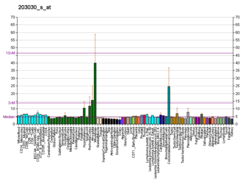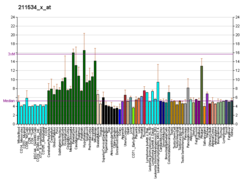Protein-coding gene in the species Homo sapiens
| PTPRN2 |
|---|
|
| Available structures |
|---|
| PDB | Ortholog search: PDBe RCSB |
|---|
| List of PDB id codes |
|---|
2QEP, 4HTI, 4HTJ |
|
|
| Identifiers |
|---|
| Aliases | PTPRN2, IA-2beta, IAR, ICAAR, PTPRP, R-PTP-N2, protein tyrosine phosphatase, receptor type N2, protein tyrosine phosphatase receptor type N2 |
|---|
| External IDs | OMIM: 601698; MGI: 107418; HomoloGene: 2134; GeneCards: PTPRN2; OMA:PTPRN2 - orthologs |
|---|
| Gene location (Human) |
|---|
 | | Chr. | Chromosome 7 (human)[1] |
|---|
| | Band | 7q36.3 | Start | 157,539,056 bp[1] |
|---|
| End | 158,587,823 bp[1] |
|---|
|
| Gene location (Mouse) |
|---|
 | | Chr. | Chromosome 12 (mouse)[2] |
|---|
| | Band | 12 F2|12 62.65 cM | Start | 116,449,340 bp[2] |
|---|
| End | 117,240,469 bp[2] |
|---|
|
| RNA expression pattern |
|---|
| Bgee | | Human | Mouse (ortholog) |
|---|
| Top expressed in | - middle temporal gyrus
- external globus pallidus
- Brodmann area 23
- entorhinal cortex
- orbitofrontal cortex
- frontal pole
- superior frontal gyrus
- Brodmann area 46
- postcentral gyrus
- bronchial epithelial cell
|
| | Top expressed in | - superior frontal gyrus
- cerebellar cortex
- endocrine pancreas
- islet of Langerhans
- spermatocyte
- neural tube
- supraoptic nucleus
- stomach
- hippocampus proper
- entorhinal cortex
|
| | More reference expression data |
|
|---|
| BioGPS | 

 | | More reference expression data |
|
|---|
|
| Gene ontology |
|---|
| Molecular function | - phosphoprotein phosphatase activity
- phosphatase activity
- protein tyrosine phosphatase activity
- transmembrane receptor protein tyrosine phosphatase activity
- hydrolase activity
| | Cellular component | - cytoplasm
- integral component of membrane
- endoplasmic reticulum lumen
- secretory granule membrane
- membrane
- receptor complex
- transport vesicle membrane
- synapse
- integral component of plasma membrane
- synaptic vesicle membrane
- secretory granule
- cell junction
- terminal bouton
- cytoplasmic vesicle
- plasma membrane
- ficolin-1-rich granule membrane
- integral component of synaptic vesicle membrane
| | Biological process | - protein dephosphorylation
- negative regulation of GTPase activity
- dephosphorylation
- insulin secretion involved in cellular response to glucose stimulus
- peptidyl-tyrosine dephosphorylation
- neurotransmitter secretion
- lipid metabolism
- neutrophil degranulation
| | Sources:Amigo / QuickGO |
|
| Orthologs |
|---|
| Species | Human | Mouse |
|---|
| Entrez | | |
|---|
| Ensembl | |
|---|
ENSG00000155093
ENSG00000282185 |
| |
|---|
| UniProt | | |
|---|
| RefSeq (mRNA) | |
|---|
NM_001308267
NM_001308268
NM_002847
NM_130842
NM_130843 |
| |
|---|
| RefSeq (protein) | |
|---|
NP_001295196
NP_001295197
NP_002838
NP_570857
NP_570858 |
| |
|---|
| Location (UCSC) | Chr 7: 157.54 – 158.59 Mb | Chr 12: 116.45 – 117.24 Mb |
|---|
| PubMed search | [3] | [4] |
|---|
|
| Wikidata |
| View/Edit Human | View/Edit Mouse |
|
Receptor-type tyrosine-protein phosphatase N2 (R-PTP-N2) also known as islet cell autoantigen-related protein (ICAAR) and phogrin is an enzyme that in humans is encoded by the PTPRN2 gene.[5][6][7] PTPRN and PTPRN2 (this gene) are both found to be major autoantigens associated with insulin-dependent diabetes mellitus.[7]
Function
Due to a close similarity in the gene sequences, the protein encoded by this gene has traditionally been considered a member of the protein tyrosine phosphatase (PTP) family. PTPs are known to be signaling molecules that regulate a variety of cellular processes including cell growth, differentiation, mitotic cycle, and oncogenic transformation. However, recent research has shown that the PTPRN2 mouse homolog, known as phogrin, dephosphorylates the lipid phosphatidylinositol rather than tyrosine. Specifically, phogrin was shown to act upon phosphatidylinositol 3-phosphate and Phosphatidylinositol 4,5-diphosphate, whereas it has never been observed acting upon tyrosine.[8] PTPRN2 should, therefore, be more accurately considered a PIPase rather than a PTPase. Phosphorylated forms of phosphatidylinositol (PI) are called phosphoinositides and play important roles in lipid signaling, cell signaling and membrane trafficking.
The protein produced by PTPRN2 possesses an extracellular region, a single transmembrane region, and a single intracellular catalytic domain, and thus represents a receptor-type PTP. The catalytic domain of this PTP is most closely related to PTPRN, also known as IA-2.[7]
Gene
Three alternatively spliced transcript variants of this gene, which encode distinct proteins, have been reported.[7]
Interactions
PTPRN2 has been shown to interact with: CKAP5,[9] SPTBN4,[10] and UBQLN4.[11]
Clinical significance
R-PTP-N2 functions as an autoantigen in diabetes mellitus type 1.[12][13]
References
- ^ a b c ENSG00000282185 GRCh38: Ensembl release 89: ENSG00000155093, ENSG00000282185 – Ensembl, May 2017
- ^ a b c GRCm38: Ensembl release 89: ENSMUSG00000056553 – Ensembl, May 2017
- ^ "Human PubMed Reference:". National Center for Biotechnology Information, U.S. National Library of Medicine.
- ^ "Mouse PubMed Reference:". National Center for Biotechnology Information, U.S. National Library of Medicine.
- ^ Smith PD, Barker KT, Wang J, Lu YJ, Shipley J, Crompton MR (Jan 1997). "ICAAR, a novel member of a new family of transmembrane, tyrosine phosphatase-like proteins". Biochem Biophys Res Commun. 229 (2): 402–11. doi:10.1006/bbrc.1996.1817. PMID 8954911.
- ^ Li Q, Borovitskaya AE, DeSilva MG, Wasserfall C, Maclaren NK, Notkins AL, Lan MS (Sep 1997). "Autoantigens in insulin-dependent diabetes mellitus: molecular cloning and characterization of human IA-2 beta". Proc Assoc Am Physicians. 109 (4): 429–39. PMID 9220540.
- ^ a b c d "Entrez Gene: PTPRN2 protein tyrosine phosphatase, receptor type, N polypeptide 2".
- ^ Caromile LA, Oganesian A, Coats SA, Seifert RA, Bowen-Pope DF (April 2010). "The neurosecretory vesicle protein phogrin functions as a phosphatidylinositol phosphatase to regulate insulin secretion". J. Biol. Chem. 285 (14): 10487–96. doi:10.1074/jbc.M109.066563. PMC 2856256. PMID 20097759.
- ^ Nakayama M, Kikuno R, Ohara O (November 2002). "Protein-protein interactions between large proteins: two-hybrid screening using a functionally classified library composed of long cDNAs". Genome Res. 12 (11): 1773–84. doi:10.1101/gr.406902. PMC 187542. PMID 12421765.
- ^ Berghs S, Aggujaro D, Dirkx R, Maksimova E, Stabach P, Hermel JM, Zhang JP, Philbrick W, Slepnev V, Ort T, Solimena M (November 2000). "betaIV spectrin, a new spectrin localized at axon initial segments and nodes of ranvier in the central and peripheral nervous system". J. Cell Biol. 151 (5): 985–1002. doi:10.1083/jcb.151.5.985. PMC 2174349. PMID 11086001.
- ^ Lim J, Hao T, Shaw C, Patel AJ, Szabó G, Rual JF, Fisk CJ, Li N, Smolyar A, Hill DE, Barabási AL, Vidal M, Zoghbi HY (May 2006). "A protein-protein interaction network for human inherited ataxias and disorders of Purkinje cell degeneration". Cell. 125 (4): 801–14. doi:10.1016/j.cell.2006.03.032. PMID 16713569. S2CID 13709685.
- ^ Lu J, Li Q, Xie H, Chen ZJ, Borovitskaya AE, Maclaren NK, Notkins AL, Lan MS (March 1996). "Identification of a second transmembrane protein tyrosine phosphatase, IA-2beta, as an autoantigen in insulin-dependent diabetes mellitus: precursor of the 37-kDa tryptic fragment". Proc. Natl. Acad. Sci. U.S.A. 93 (6): 2307–11. Bibcode:1996PNAS...93.2307L. doi:10.1073/pnas.93.6.2307. PMC 39791. PMID 8637868.
- ^ Pietropaolo M, Hutton JC, Eisenbarth GS (February 1997). "Protein tyrosine phosphatase-like proteins: link with IDDM". Diabetes Care. 20 (2): 208–14. doi:10.2337/diacare.20.2.208. PMID 9118776. S2CID 5392803.
Further reading
- Lan MS, Lu J, Goto Y, Notkins AL (1994). "Molecular cloning and identification of a receptor-type protein tyrosine phosphatase, IA-2, from human insulinoma". DNA Cell Biol. 13 (5): 505–14. doi:10.1089/dna.1994.13.505. PMID 8024693.
- Cui L, Yu WP, DeAizpurua HJ, et al. (1996). "Cloning and characterization of islet cell antigen-related protein-tyrosine phosphatase (PTP), a novel receptor-like PTP and autoantigen in insulin-dependent diabetes". J. Biol. Chem. 271 (40): 24817–23. doi:10.1074/jbc.271.40.24817. PMID 8798755.
- Kawasaki E, Hutton JC, Eisenbarth GS (1996). "Molecular cloning and characterization of the human transmembrane protein tyrosine phosphatase homologue, phogrin, an autoantigen of type 1 diabetes". Biochem. Biophys. Res. Commun. 227 (2): 440–7. doi:10.1006/bbrc.1996.1526. PMID 8878534.
- Schmidli RS, Colman PG, Cui L, et al. (1998). "Antibodies to the protein tyrosine phosphatases IAR and IA-2 are associated with progression to insulin-dependent diabetes (IDDM) in first-degree relatives at-risk for IDDM". Autoimmunity. 28 (1): 15–23. doi:10.3109/08916939808993841. PMID 9754810.
- van den Maagdenberg AM, Schepens JT, Schepens MT, et al. (1999). "Assignment of Ptprn2, the gene encoding receptor-type protein tyrosine phosphatase IA-2beta, a major autoantigen in insulin-dependent diabetes mellitus, to mouse chromosome region 12F". Cytogenet. Cell Genet. 82 (3–4): 153–5. doi:10.1159/000015090. PMID 9858807. S2CID 46872092.
- Berghs S, Aggujaro D, Dirkx R, et al. (2001). "betaIV spectrin, a new spectrin localized at axon initial segments and nodes of ranvier in the central and peripheral nervous system". J. Cell Biol. 151 (5): 985–1002. doi:10.1083/jcb.151.5.985. PMC 2174349. PMID 11086001.
- Kubosaki A, Gross S, Miura J, et al. (2004). "Targeted disruption of the IA-2beta gene causes glucose intolerance and impairs insulin secretion but does not prevent the development of diabetes in NOD mice". Diabetes. 53 (7): 1684–91. doi:10.2337/diabetes.53.7.1684. PMID 15220191.
- Lim J, Hao T, Shaw C, et al. (2006). "A protein-protein interaction network for human inherited ataxias and disorders of Purkinje cell degeneration". Cell. 125 (4): 801–14. doi:10.1016/j.cell.2006.03.032. PMID 16713569. S2CID 13709685.
 | This article on a gene on human chromosome 7 is a stub. You can help Wikipedia by expanding it. |



















